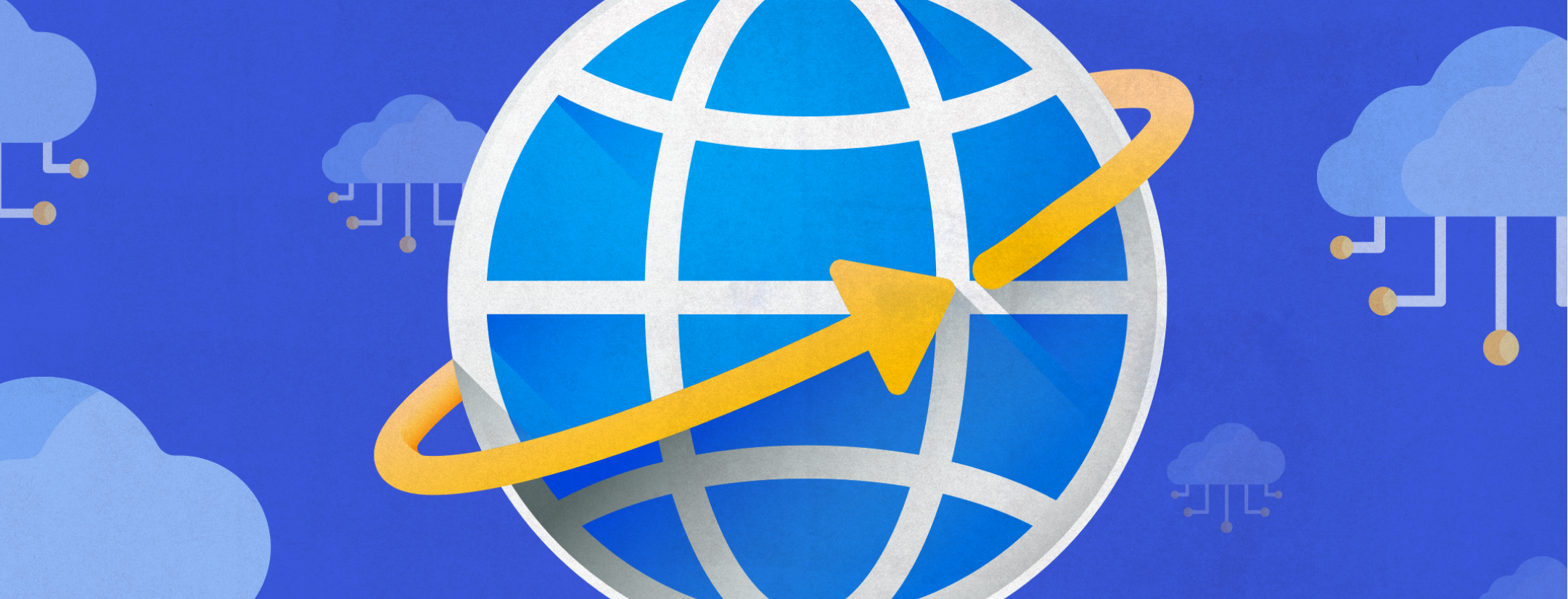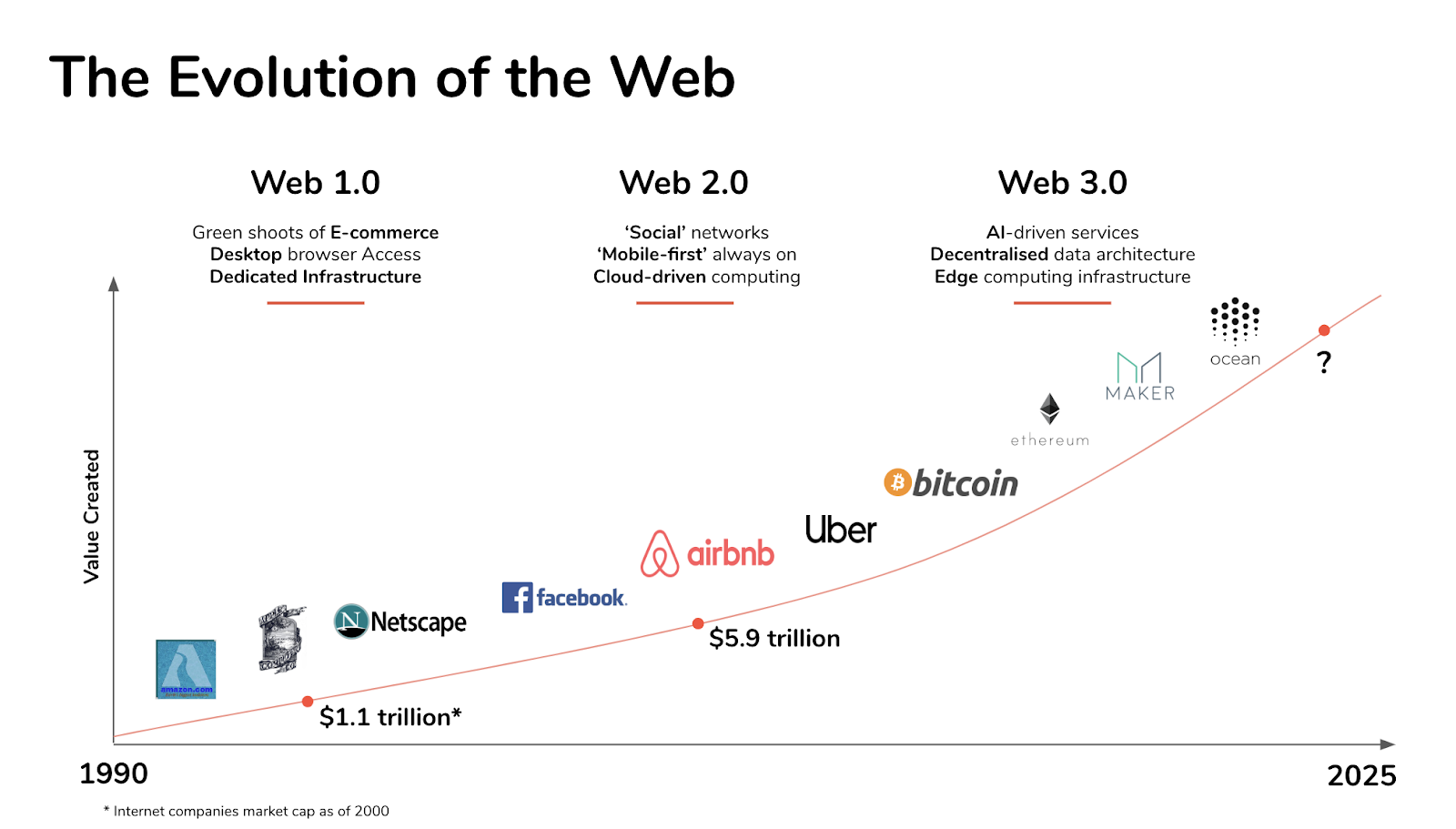
Web 3.0 is here. Don’t Let Your Digital Product Fall behind.
- Product Definition /
- Product Development /
- Product Strategy /
The internet is in the early stages of a monumental shift. The predominant paradigms that are collectively known as Web 2.0 are beginning to be displaced by newer technologies that will dramatically change how we interact with digital products. As a product owner, you need to know how these shifts and trends will impact your product’s roadmap. You may be wondering if you quickly need to pivot to embrace these rapid technology changes. Do any of these shifts put your product in danger of losing your current user base to competitors? There may also be major opportunities for growth on the landscape as well and understanding these trends will help you capture them.
Over the last decade, the Web 2.0 trends focused product development on mobile-first UX, social networks, and cloud-hosted user-generated content. While these trends will presumably continue to influence how we build digital products, the new emerging trends promise to transcend the impact of Web 2.0 on our society. These trends are collectively known as Web 3.0.
What is the difference between Web 2.0 and Web 3.0?
Since the late 2000s, the internet has been dominated by social networks, cloud computing, and the arrival of smartphones. This phase of the internet is referred to as Web 2.0. TikTok is demonstrative of these developments coalescing to enable a digital product: TikTok uses social network dynamics to allow the sharing of video content captured on smartphones, leveraging distributed computing cloud computing networks to process videos in real time and making them available to users anywhere in the world.

3 Key Trends As The Internet Evolves to Web 3.0
Web 3.0 merges three new trends: decentralization, artificial intelligence, and edge computing. Collectively, these could have an even greater impact over the next decade than Web 2.0 has had so far. Let’s dive into each one of these three macro trends.
Machine Learning and Artificial Intelligence will Replace Human Decision Making
The first significant trend in Web 3.0 is the proliferation of Machine Learning (ML) and Artificial Intelligence (AI) algorithms. What used to be fringe technologies are now weaved into our lives and appear everywhere we turn whether we realize it or not. They have become powerful enough to create useful, indeed sometimes life-saving predictions and actions, while also improving simple tasks in our day-to-day life. From powering voice-controlled assistants in our homes, to enabling self-driving cars and breakthroughs in medicine, ML algorithms are already changing the way we live today. When layered on top of new decentralized data structures a wealth of data that would be the envy of today’s tech giants becomes accessible. The potential applications go far beyond voice assistants into areas like precision materials, drug design, and climate modeling.
Use cases within digital products are also continuously growing. There are facets of the underlying machine-learning technology that can elevate your digital product to the next echelon. This is enabled by combining cutting-edge AI capabilities with modern, best-practice APIs. This amalgamation enables the integration of AI into your digital products without the need to deploy your own AI engine and train your own models. If you are looking for ways to leverage AI capabilities in your digital product, visit our article on how to employ AI in your digital product strategy.
It is also important to address how implementing AI affects your application’s user experience, particularly in regard to trust and control issues between your users and the AI-powered applications. You are, after all, asking a machine to make decisions or complete tasks that typically would be handled by a human. Without insight as to why or how a machine is making a decision for us, we must rethink the ramifications of this choice. If you are wondering how to create a seamless user experience, blending traditional application functionality with AI-powered capabilities, you can learn more in our article about the most important UX guidelines to embed AI in your digital products.
Edge Computing will Allow Supercomputer Processing Power from Anywhere
Over the last two decades, computing power and data storage have been heavily centralized in large data centers filled floor to ceiling with server racks, often thousands of miles away from the human interface devices that produce or consume the data. As the computing power in consumer devices, such as phones, computers, appliances, sensors, and vehicles, becomes more powerful, the servers at the center of the network are being supplemented at the edges, often right in our hands. Computing tasks that previously were limited to be performed only in expensive data centers can now be executed closer to, if not directly, at the location where the data is being collected. This enables new use cases that require large amounts of data to be processed in real time, and where bandwidth costs or transmission delays would have rendered them unattainable.
Before edge computing, for example, a video feed from a security camera or smartphone would need to travel to a distant cloud data center, where powerful servers would run facial recognition algorithms before returning the results. This process would consume bandwidth and time to process, which introduces scalability limitations for larger use cases with hundreds of camera feeds or real time information requirements. In an edge computing architecture local edge servers, cameras, or even smartphones themselves could run the facial recognition algorithms. Web 3.0 opens opportunities for new use cases, such as virtual and augmented reality, autonomous vehicles, and smart cities.
Decentralization will Revolutionize Global Commerce
The third of the paradigm changes in Web 3.0 is the migration of resources away from centralized companies, which currently control large parts of the internet’s infrastructure and data, to decentralized networks and organizations. This is arguably the hardest change to comprehend, so I will cover it in a little more detail.
The most prominent implementations of these principles so far have been in the blockchain space (confusingly also referred to as web3), particularly cryptocurrencies, although many other use cases are emerging. Here are the key attributes of the decentralized internet and the digital products that inhabit the space:
1. Trustless
Current digital products rely on trusted infrastructure, meaning only permissioned servers can run the application backend and participate in the product ecosystem. In a trustless infrastructure, trust that was previously required of a single, centralized actor (such as a database server) is now distributed so widely amongst all the nodes in the system, that trust in any one single node is no longer required, leading to trustlessness. Every node operating within the ecosystem is incentivized by economic models to act correctly and cooperate with others.
With the decentralized internet, people, machines, and businesses will be able to trade value, information, and work with global counterparties they don’t know or explicitly trust, without an intermediary. Web3 enables the minimization of the trust required for coordination on a global scale, removing gatekeepers and middlemen from global commerce.
2. Permissionless
Until now our digital products have relied heavily on gatekeepers and permissioned access. For example, your online bank needs to decide if you are worthy of having an account with them, and Twitter controls if you can participate on their platform. As a product owner, you likely have control over who is able to use your digital product.
Web3 pushes the notion of permissionless access, allowing anyone within a system’s ruleset to participate in that system. The increasing digitization of assets on which these rules rely makes this possible. For example, in web3 today anyone can take out a financial loan on a borrowing platform, such as Aave or Compound, as long as they meet the collateral requirements programmed into the contract. Since all assets involved in these transactions are digitized (in this case cryptocurrencies), the platforms can enforce all rules programmatically. There is no gatekeeper to review your credit history or financial statements, although once identity and creditworthiness are established and digitized these could potentially become part of a contract’s rulesets as well. As more real-world assets are digitized (such as home or car titles), these features could all become part of the web3 ecosystem.
3. Ownership
Decentralized systems eliminate the possibility of large-scale control of users’ data and assets, instead shifting that responsibility to users. But with control comes power, and users need to be prepared to assume the responsibility of owning and managing their own data. For example, if a user loses their private key, which is used to provide secure access to their data assets on a blockchain, they might lose access to all their data assets. In the case of a currency account, losing the private key means losing all funds in the account, and there is no middleman (such as a bank) to mitigate the loss.
A current example of a digital product that decentralizes ownership of data is the Brave web browser. By default, this browser blocks all ads and tracking cookies on websites the user visits. Instead, it runs its own ad network with tight ad-tracking controls where users get to decide how many ads they want to see and receive 70% of the resulting ad revenues. This puts the users in control of how their attention is monetized and gives them a share of the generated revenue.
4. Autonomy
Private enterprises, which are centralized both politically and architecturally, have been the dominant drivers within the economic structure of the 20th century. Misalignment of interests between shareholders, operators, users, and customers – a legacy of the industrial revolution codified in for-profit corporations – has created an environment of broken promises and mistrust.
Web3 introduces new structures, such as Decentralized Autonomous Organizations (DAO), which are smart contract systems containing the business and governance rules for how to operate. These organizations can realign the economic interest of all stakeholders, reducing friction and removing middlemen. Digital products, once owned by centralized corporations, can now be part of DAOs, where ownership and control are decentralized. This prevents a single company or government from calling all the shots. For example, MakerDAO is an organization that builds and operates decentralized financial products, and anyone owning MKR governance tokens can participate in setting the rules by which the organization runs and operates its products. While initially, the governance tokens are fairly centralized, over time—as tokens are distributed through normal operations—control over the organization becomes increasingly more decentralized.
What lies ahead in web3 goes far beyond the initial use case of cryptocurrencies. Through the variety of interactions now possible, as well as the global scope of counterparties available, web3 will cryptographically connect data from individuals, corporations, and machines. This will lead to the rise of fundamentally new markets and associated business models.
Web 3.0 will Generate Tremendous Societal Change
The changes to our everyday lives brought on by social networks, cloud computing, and mobile technology have been deep and long-lasting, yet I believe Web 2.0 has only been a stepping stone towards the larger changes enabled by Web 3.0. Looking back at the impact of Web 2.0 on humanity, we should brace ourselves for even bigger repercussions moving forward. Artificial intelligence will disrupt labor markets, decentralization has the potential to restructure entire societies, and edge computing will literally put the power of supercomputers at our fingertips. Only time will tell how much these changes will evolve our lives, but there still is time to front-run some of the largest technological opportunities since the industrial revolution and shift your digital product to be part of this transformation.